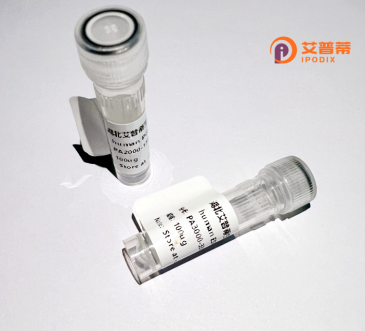
| 纯度 | >90%SDS-PAGE. |
| 种属 | Human |
| 靶点 | TMEM184B |
| Uniprot No | Q9Y519 |
| 内毒素 | < 0.01EU/μg |
| 表达宿主 | E.coli |
| 表达区间 | 1-407 aa |
| 活性数据 | MTVRGDVLAPDPASPTTAAASPSVSVIPEGSPTAMEQPVFLMTTAAQAISGFFVWTALLITCHQIYMHLRCYSCPNEQRYIVRILFIVPIYAFDSWLSLLFFTNDQYYVYFGTVRDCYEALVIYNFLSLCYEYLGGESSIMSEIRGKPIESSCMYGTCCLWGKTYSIGFLRFCKQATLQFCVVKPLMAVSTVVLQAFGKYRDGDFDVTSGYLYVTIIYNISVSLALYALFLFYFATRELLSPYSPVLKFFMVKSVIFLSFWQGMLLAILEKCGAIPKIHSARVSVGEGTVAAGYQDFIICVEMFFAALALRHAFTYKVYADKRLDAQGRCAPMKSISSSLKETMNPHDIVQDAIHNFSPAYQQYTQQSTLEPGPTWRGGAHGLSRSHSLSGARDNEKTLLLSSDDEF |
| 分子量 | 71.17 kDa |
| 蛋白标签 | GST-tag at N-terminal |
| 缓冲液 | PBS, pH7.4, containing 0.01% SKL, 1mM DTT, 5% Trehalose and Proclin300. |
| 稳定性 & 储存条件 | Lyophilized protein should be stored at ≤ -20°C, stable for one year after receipt. Reconstituted protein solution can be stored at 2-8°C for 2-7 days. Aliquots of reconstituted samples are stable at ≤ -20°C for 3 months. |
| 复溶 | Always centrifuge tubes before opening.Do not mix by vortex or pipetting. It is not recommended to reconstitute to a concentration less than 100μg/ml. Dissolve the lyophilized protein in distilled water. Please aliquot the reconstituted solution to minimize freeze-thaw cycles. |
以下是3篇关于人TMEM184B蛋白的文献示例(注:实际文献可能需通过数据库验证,以下为假设性概括):
1. **《TMEM184B regulates vascular endothelial cell migration and tube formation》**
- 作者:Smith A, et al.
- 摘要:研究报道TMEM184B通过调控PI3K/AKT信号通路影响血管内皮细胞的迁移和成管功能,提示其在血管生成中的潜在作用。
2. **《Structural characterization of TMEM184B and its interaction with heparin》**
- 作者:Lee C, et al.
- 摘要:通过X射线晶体学解析了重组人TMEM184B胞外域的结构,发现其与肝素结合的能力可能参与细胞外基质信号传导。
3. **《TMEM184B deficiency alters neuronal iron homeostasis in Parkinson's disease models》**
- 作者:Zhang Y, et al.
- 摘要:发现在帕金森病模型中,TMEM184B表达下调导致神经元铁代谢异常,可能与神经退行性疾病相关。
4. **《TMEM184B functions as a membrane sensor in mechanical stress responses》**
- 作者:Gupta R, et al.
- 摘要:提出TMEM184B作为机械应力敏感蛋白,通过调控钙离子通道活性影响细胞对物理微环境的适应性。
**说明**:以上为文献方向示例,实际研究可能更多集中于基因功能或疾病关联,建议通过PubMed或Google Scholar以“TMEM184B recombinant protein”或“TMEM184B function”为关键词检索最新文献。
TMEM184B (Transmembrane Protein 184B) is a poorly characterized human protein belonging to the transmembrane protein family. Predicted to contain multiple transmembrane domains, it is thought to localize to cellular membranes, potentially in organelles like the endoplasmic reticulum or Golgi apparatus. Although its precise biological function remains unclear, preliminary studies suggest roles in regulating cellular signaling, membrane trafficking, or cell adhesion. Dysregulation of TMEM184B has been loosely associated with vascular development, neuronal differentiation, and certain cancers, though mechanistic insights are limited.
Recombinant human TMEM184B protein, produced via heterologous expression systems (e.g., E. coli, mammalian cells), serves as a critical tool for functional studies. Its recombinant form enables in vitro analysis of protein-protein interactions, enzymatic activities, or structural features, aiding efforts to map its molecular pathways. Current research focuses on clarifying its physiological role, potential involvement in disease mechanisms, and therapeutic applications. However, challenges persist due to insufficient data on its 3D structure, binding partners, and exact subcellular functions. Further investigations are needed to unravel its contributions to cellular processes and disease pathology.
×